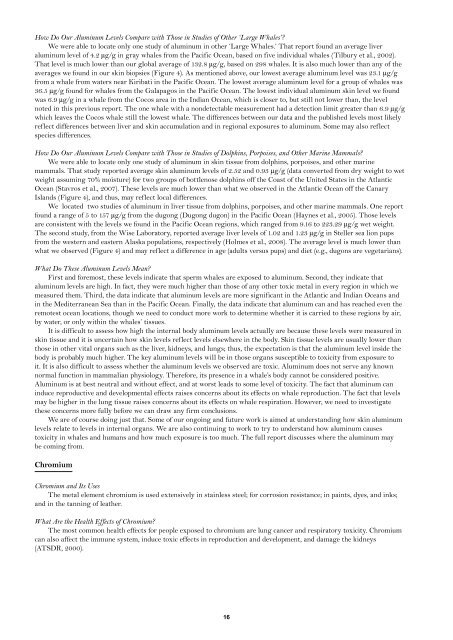Voyage of the Odyssey executive summary - Ocean Alliance
Voyage of the Odyssey executive summary - Ocean Alliance
Voyage of the Odyssey executive summary - Ocean Alliance
Create successful ePaper yourself
Turn your PDF publications into a flip-book with our unique Google optimized e-Paper software.
How Do Our Aluminum Levels Compare with Those in Studies <strong>of</strong> O<strong>the</strong>r ‘Large Whales’?<br />
We were able to locate only one study <strong>of</strong> aluminum in o<strong>the</strong>r ‘Large Whales.’ That report found an average liver<br />
aluminum level <strong>of</strong> 4.2 μg/g in gray whales from <strong>the</strong> Pacific <strong>Ocean</strong>, based on five individual whales (Tilbury et al., 2002).<br />
That level is much lower than our global average <strong>of</strong> 132.8 μg/g, based on 298 whales. It is also much lower than any <strong>of</strong> <strong>the</strong><br />
averages we found in our skin biopsies (Figure 4). As mentioned above, our lowest average aluminum level was 23.1 μg/g<br />
from a whale from waters near Kiribati in <strong>the</strong> Pacific <strong>Ocean</strong>. The lowest average aluminum level for a group <strong>of</strong> whales was<br />
36.5 μg/g found for whales from <strong>the</strong> Galapagos in <strong>the</strong> Pacific <strong>Ocean</strong>. The lowest individual aluminum skin level we found<br />
was 6.9 μg/g in a whale from <strong>the</strong> Cocos area in <strong>the</strong> Indian <strong>Ocean</strong>, which is closer to, but still not lower than, <strong>the</strong> level<br />
noted in this previous report. The one whale with a nondetectable measurement had a detection limit greater than 6.9 μg/g<br />
which leaves <strong>the</strong> Cocos whale still <strong>the</strong> lowest whale. The differences between our data and <strong>the</strong> published levels most likely<br />
reflect differences between liver and skin accumulation and in regional exposures to aluminum. Some may also reflect<br />
species differences.<br />
How Do Our Aluminum Levels Compare with Those in Studies <strong>of</strong> Dolphins, Porpoises, and O<strong>the</strong>r Marine Mammals?<br />
We were able to locate only one study <strong>of</strong> aluminum in skin tissue from dolphins, porpoises, and o<strong>the</strong>r marine<br />
mammals. That study reported average skin aluminum levels <strong>of</strong> 2.52 and 0.93 μg/g (data converted from dry weight to wet<br />
weight assuming 70% moisture) for two groups <strong>of</strong> bottlenose dolphins <strong>of</strong>f <strong>the</strong> Coast <strong>of</strong> <strong>the</strong> United States in <strong>the</strong> Atlantic<br />
<strong>Ocean</strong> (Stavros et al., 2007). These levels are much lower than what we observed in <strong>the</strong> Atlantic <strong>Ocean</strong> <strong>of</strong>f <strong>the</strong> Canary<br />
Islands (Figure 4), and thus, may reflect local differences.<br />
We located two studies <strong>of</strong> aluminum in liver tissue from dolphins, porpoises, and o<strong>the</strong>r marine mammals. One report<br />
found a range <strong>of</strong> 5 to 157 μg/g from <strong>the</strong> dugong (Dugong dugon) in <strong>the</strong> Pacific <strong>Ocean</strong> (Haynes et al., 2005). Those levels<br />
are consistent with <strong>the</strong> levels we found in <strong>the</strong> Pacific <strong>Ocean</strong> regions, which ranged from 9.16 to 223.29 μg/g wet weight.<br />
The second study, from <strong>the</strong> Wise Laboratory, reported average liver levels <strong>of</strong> 1.02 and 1.23 μg/g in Steller sea lion pups<br />
from <strong>the</strong> western and eastern Alaska populations, respectively (Holmes et al., 2008). The average level is much lower than<br />
what we observed (Figure 4) and may reflect a difference in age (adults versus pups) and diet (e.g., dugons are vegetarians).<br />
What Do These Aluminum Levels Mean?<br />
First and foremost, <strong>the</strong>se levels indicate that sperm whales are exposed to aluminum. Second, <strong>the</strong>y indicate that<br />
aluminum levels are high. In fact, <strong>the</strong>y were much higher than those <strong>of</strong> any o<strong>the</strong>r toxic metal in every region in which we<br />
measured <strong>the</strong>m. Third, <strong>the</strong> data indicate that aluminum levels are more significant in <strong>the</strong> Atlantic and Indian <strong>Ocean</strong>s and<br />
in <strong>the</strong> Mediterranean Sea than in <strong>the</strong> Pacific <strong>Ocean</strong>. Finally, <strong>the</strong> data indicate that aluminum can and has reached even <strong>the</strong><br />
remotest ocean locations, though we need to conduct more work to determine whe<strong>the</strong>r it is carried to <strong>the</strong>se regions by air,<br />
by water, or only within <strong>the</strong> whales’ tissues.<br />
It is difficult to assess how high <strong>the</strong> internal body aluminum levels actually are because <strong>the</strong>se levels were measured in<br />
skin tissue and it is uncertain how skin levels reflect levels elsewhere in <strong>the</strong> body. Skin tissue levels are usually lower than<br />
those in o<strong>the</strong>r vital organs such as <strong>the</strong> liver, kidneys, and lungs; thus, <strong>the</strong> expectation is that <strong>the</strong> aluminum level inside <strong>the</strong><br />
body is probably much higher. The key aluminum levels will be in those organs susceptible to toxicity from exposure to<br />
it. It is also difficult to assess whe<strong>the</strong>r <strong>the</strong> aluminum levels we observed are toxic. Aluminum does not serve any known<br />
normal function in mammalian physiology. Therefore, its presence in a whale’s body cannot be considered positive.<br />
Aluminum is at best neutral and without effect, and at worst leads to some level <strong>of</strong> toxicity. The fact that aluminum can<br />
induce reproductive and developmental effects raises concerns about its effects on whale reproduction. The fact that levels<br />
may be higher in <strong>the</strong> lung tissue raises concerns about its effects on whale respiration. However, we need to investigate<br />
<strong>the</strong>se concerns more fully before we can draw any firm conclusions.<br />
We are <strong>of</strong> course doing just that. Some <strong>of</strong> our ongoing and future work is aimed at understanding how skin aluminum<br />
levels relate to levels in internal organs. We are also continuing to work to try to understand how aluminum causes<br />
toxicity in whales and humans and how much exposure is too much. The full report discusses where <strong>the</strong> aluminum may<br />
be coming from.<br />
Chromium<br />
Chromium and Its Uses<br />
The metal element chromium is used extensively in stainless steel; for corrosion resistance; in paints, dyes, and inks;<br />
and in <strong>the</strong> tanning <strong>of</strong> lea<strong>the</strong>r.<br />
What Are <strong>the</strong> Health Effects <strong>of</strong> Chromium?<br />
The most common health effects for people exposed to chromium are lung cancer and respiratory toxicity. Chromium<br />
can also affect <strong>the</strong> immune system, induce toxic effects in reproduction and development, and damage <strong>the</strong> kidneys<br />
(ATSDR, 2000).<br />
16


